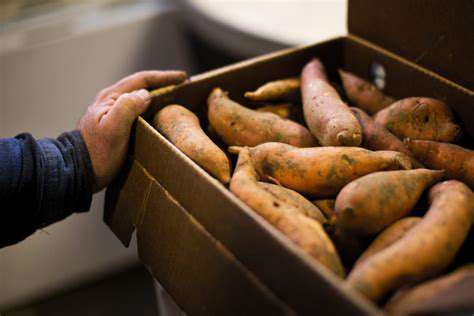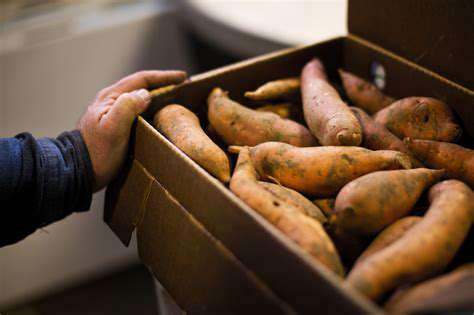How to Store Sweet Potatoes: Proper Storage
Aug 25, 2025 / btwgardenmachine/

Effective Sweet Potato Storage Methods
Proper Harvesting for Optimal Storage
Harvesting sweet potatoes at the right time is crucial for their longevity. Ideally, you should harvest sweet potatoes when the vines begin to die back, usually in the fall. Waiting until the leaves have completely withered ensures the potatoes have properly developed their starch content and are ready for long-term storage. Improperly harvested potatoes will likely spoil faster.
To ensure a clean harvest, gently dig around the sweet potato plants, being careful not to damage the tubers. Avoid digging directly on the potatoes to minimize any soil particles clinging to the surface, which can promote rot. Once harvested, inspect the potatoes, removing any that show signs of damage or disease. Proper harvesting practices are fundamental to successful sweet potato storage.
Ideal Storage Temperature and Humidity
Sweet potatoes thrive in a cool, dry environment. The ideal storage temperature range is between 55-60°F (13-16°C). Maintaining a consistent temperature is key to preventing premature sprouting and decay. Fluctuations in temperature can significantly shorten the shelf life of your sweet potatoes.
Humidity levels should also be moderate, ideally between 85-90%. Too low humidity can cause the potatoes to dry out, while excessively high humidity can promote fungal growth. A well-ventilated storage area, away from direct sunlight, is essential for optimal storage conditions.
Using a Cool, Dark Environment
Sweet potatoes, like many root vegetables, benefit from a cool, dark environment. Avoid storing them in areas exposed to direct sunlight or fluctuating temperatures. A basement or root cellar, if available, offers an excellent environment for long-term storage.
Proper Handling and Cleaning
Before storing, carefully handle the sweet potatoes to prevent damage. Avoid rough handling, as this can lead to bruising and accelerate decay. Gently brush off loose soil, but avoid washing the potatoes until just before use. Washing them too early can increase the risk of moisture-related issues during storage.
Choosing the Right Storage Containers
Use breathable containers for storing sweet potatoes. Avoid airtight containers, as they can trap moisture and encourage rot. Paper bags or mesh bags are good options, as they allow for proper air circulation. Ensure the containers are clean and dry to prevent the growth of mold or bacteria.
Preventing Pests and Diseases
Inspect the sweet potatoes regularly for signs of pests or diseases. If any problems arise, isolate the affected potatoes to prevent the spread of infection. Proper ventilation and a clean storage environment significantly reduce the risk of infestations. Keeping a watchful eye on storage conditions is vital for maintaining the quality of your sweet potatoes.
Long-Term Storage Strategies
For extended storage, consider storing sweet potatoes in a cool, dark, and dry place, like a root cellar or a dedicated cool, well-ventilated area of a basement. Properly stored sweet potatoes can last for several months. Monitor the potatoes regularly for any signs of deterioration. Proper long-term storage techniques can greatly extend the lifespan of your sweet potato harvest.
Maintaining Sweet Potato Quality During Storage

Proper Harvesting Techniques
Harvesting sweet potatoes at the optimal time is crucial for maintaining their quality. Waiting too long can result in diminished sweetness and potentially a loss of stored nutrients. Sweet potatoes are typically ready for harvest when the vines begin to die back, usually in the fall. Inspect the leaves for browning and wilting to determine if the plant is nearing its harvest time. Careful digging is essential to avoid damaging the tubers. Avoid pulling them out directly. Using a digging fork or shovel, gently loosen the soil around the base of the plant to avoid damaging the roots.
Storage Practices for Optimal Freshness
Proper storage is paramount to preserving the quality and taste of sweet potatoes. Store them in a cool, dark, and well-ventilated area, ideally between 55 and 60 degrees Fahrenheit (13 to 16 degrees Celsius). A basement or root cellar is ideal, if available. Avoid storing them near strong-smelling foods as the sweet potato can absorb odors. A crucial step to maintain quality is to select only the healthiest-looking sweet potatoes for storage. Inspect for any signs of damage, bruising, or rot.
Preventing Spoilage and Rot
Preventing spoilage is a critical aspect of maintaining sweet potato quality. Keeping sweet potatoes properly ventilated is a crucial step in preventing rot and decay. This is often overlooked. Improper ventilation can lead to moisture buildup, which can accelerate the growth of mold and bacteria. Avoid storing sweet potatoes in plastic bags or tightly sealed containers as this traps moisture and encourages spoilage.
Maintaining Ideal Humidity Levels
Maintaining the right humidity level is essential for preventing sweet potatoes from drying out or becoming too moist. High humidity can lead to decay, while low humidity can cause dehydration and shriveling. If your storage area is too dry, consider placing the sweet potatoes in a mesh bag or on a bed of slightly moist peat moss. This helps maintain a stable moisture level around the potatoes. Check regularly for signs of rot, and remove any affected tubers immediately to prevent the spread of decay.
Proper Handling and Preparation
Even after harvesting and storing, careful handling and preparation are crucial for maintaining quality. Thoroughly wash the sweet potatoes before use to remove any dirt or debris. Avoid scrubbing them too vigorously as this can damage the skin and make them more susceptible to bruising. Proper preparation techniques will ensure that you enjoy the full flavor and texture of the sweet potato. Cutting or peeling them should be done just before cooking to avoid oxidation which can impact color and texture.